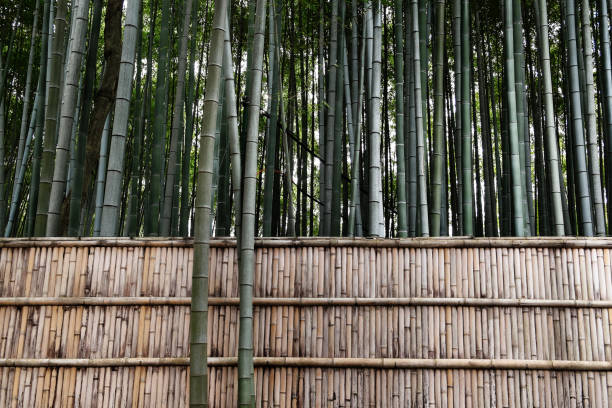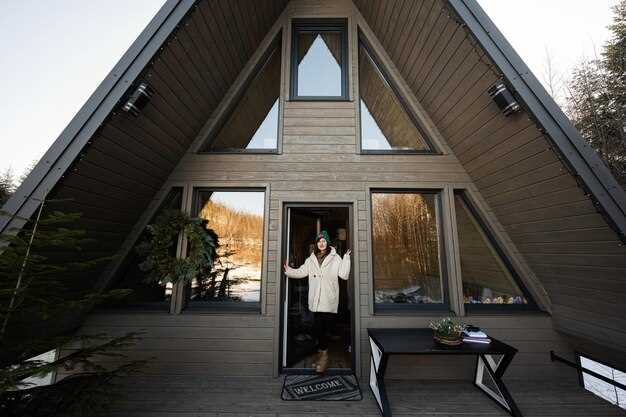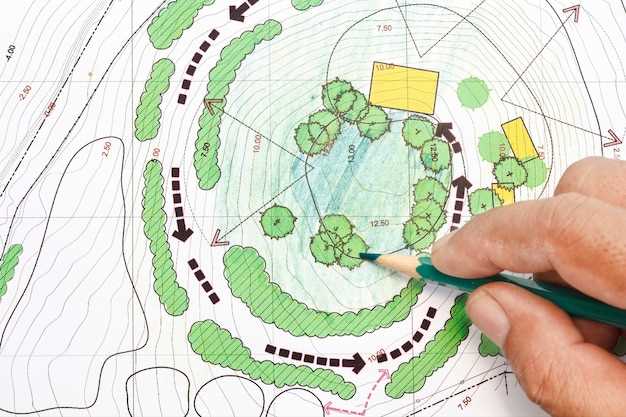Choose bamboo as your primary construction material if you’re aiming for strength and sustainability. This natural resource combines robust physical properties with ecological benefits, offering remarkable structural integrity comparable to traditional building materials.
On average, bamboo boasts a tensile strength of 28,000 pounds per square inch, far exceeding that of steel. Its cellular structure provides a unique blend of flexibility and sturdiness, allowing it to withstand seismic forces and high winds. This resilience makes bamboo particularly suitable for regions prone to natural disasters.
Another advantage of using bamboo is its rapid growth. Certain species reach maturity in just 3 to 5 years, compared to decades for conventional timber. This rapid renewability ensures a continuous supply, making it an environmentally responsible choice. Moreover, bamboo’s natural resistance to pests and fungi reduces the need for chemical treatments, contributing to a healthier building environment.
When incorporating bamboo into your construction projects, consider local availability, treatment methods, and design techniques to optimize its use. Engineered bamboo products, such as laminated bamboo panels, enhance its versatility, enabling innovative architectural designs without compromising on strength.
Building with Bamboo: Harnessing Its Full Potential for Wellness Spaces
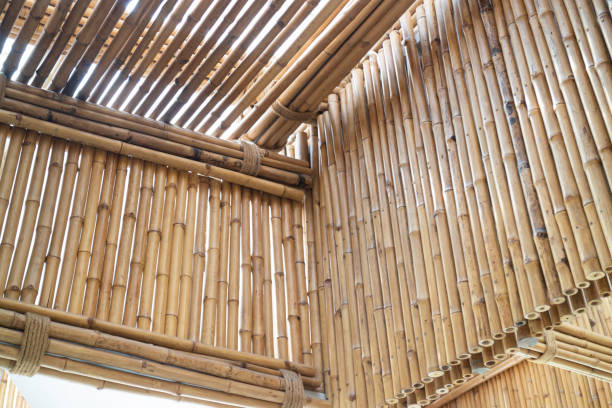
Choose bamboo to create functional and soothing wellness spaces. Its natural aesthetics and robust qualities make it perfect for environments focused on relaxation and health.
- Improved Air Quality: Bamboo’s natural ability to absorb toxins and release oxygen improves air quality in wellness spaces, promoting a healthier atmosphere.
- Enhanced Acoustics: Utilize bamboo panels for their sound-absorbing properties. This contributes to a tranquil environment where peace and serenity are prioritized.
- Thermal Comfort: Bamboo’s natural insulation properties help maintain a comfortable temperature, reducing the need for artificial heating and cooling systems.
- Renewable Material: Favor bamboo for its rapid growth and renewability, which makes it an eco-friendly choice for sustainable construction in wellness environments.
- Versatility in Design: Employ bamboo for various structural and decorative elements, from flooring and walls to furniture, enhancing the natural beauty and harmony of spaces.
- Durability: Trust in bamboo’s strength and resilience, ensuring long-lasting structures that withstand the test of time, even in high-humidity areas like saunas and spas.
Apply these principles to craft wellness spaces that not only serve their purpose but also contribute positively to environmental sustainability and user well-being.
Strength and Durability of Bamboo in Construction
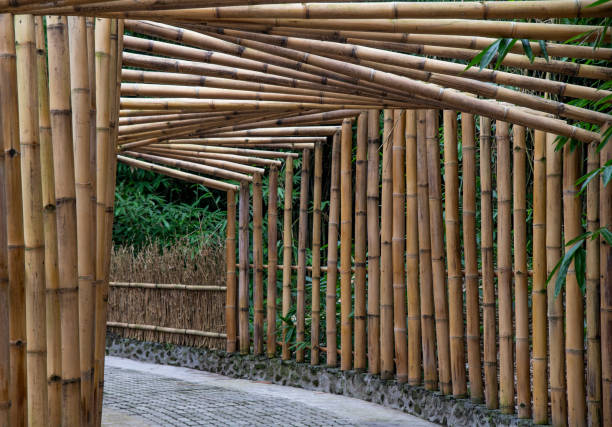
Bamboo stands out as a remarkably strong and durable material, making it an excellent choice for construction. With a tensile strength that rivals steel, bamboo offers an impressive resistance to both tension and compression. Its strength-to-weight ratio makes it highly efficient, allowing for sturdy yet lightweight structures. Research shows that bamboo’s tensile strength can reach up to 28,000 pounds per square inch, surpassing that of conventional construction materials like wood and concrete.
Durability is another significant advantage. When treated properly, bamboo becomes resistant to insects and environmental damage, providing a lifespan comparable to or even greater than traditional materials. Treatments such as borax-boric acid solutions can effectively protect bamboo from termites and rot, ensuring that structures remain robust over decades.
The cellular structure of bamboo allows it to absorb shock, making it remarkably resilient against seismic activity. Its natural flexibility provides a unique capacity to withstand earthquakes, which makes it an ideal choice for building in regions prone to such natural events. This resilience not only enhances safety but also reduces the likelihood of structural damage, resulting in lower maintenance costs.
Another benefit of bamboo in construction is its rapid growth and renewability. As a sustainably sourced material, bamboo grows back at a much faster rate than trees, reaching full maturity in just three to five years. This renewability ensures a constant supply, reducing the environmental impact of construction.
For builders seeking a sustainable and efficient alternative, bamboo presents an exceptional option. Its strength and durability, combined with its eco-friendly nature, make it a compelling choice for modern construction projects aiming for sustainability without compromising on performance and quality.
Comparative Analysis: Bamboo vs. Traditional Materials
Choose bamboo for its exceptional tensile strength, which ranges from 140 to 230 MPa, surpassing many traditional building materials like wood and concrete. Builders appreciate bamboo for its high strength-to-weight ratio, making it an ideal candidate for earthquake-resistant structures. Although steel offers higher compression strength, bamboo’s flexibility ensures greater resilience under heavy loads and stress, providing a level of safety and durability.
Bamboo stands out as a sustainable option due to its rapid growth cycle, reaching maturity in 3 to 5 years. This contrasts starkly with hardwood trees, which may take decades to grow. Environmentally conscious projects benefit from bamboo’s ability to absorb carbon dioxide and release 35% more oxygen than equivalent stands of trees. Moreover, bamboo cultivation requires fewer chemicals and fertilizers, reducing the ecological footprint of building projects.
Cost-effectiveness gives bamboo another edge over traditional materials. Despite transportation challenges in non-native regions, local sourcing significantly lowers prices in bamboo-abundant areas. Maintenance costs also decrease, as bamboo inherently resists pests and requires minimal protective treatments. Its natural beauty offers additional savings on finishes, as many builders embrace its aesthetic as-is.
For thermal efficiency, bamboo provides excellent insulation. It naturally regulates temperature, keeping indoor environments cooler in summer and warmer in winter, which leads to reduced energy costs. Concrete and steel, however, often rely heavily on additional insulation to achieve similar efficiency, raising both initial and long-term expenses.
In seismic zones, bamboo buildings have a reputation for greater safety, owing to their lesser risk of catastrophic failure due to bamboo’s elasticity and light weight. Traditional materials might fail suddenly under stress, whereas bamboo’s flexibility allows it to move with seismic waves, improving overall structural integrity.
Incorporating bamboo into building projects not only supports environmental sustainability but also offers practical, cost-effective, and resilient solutions compared to conventional materials. Choose bamboo for a flexible, sustainable, and strong building alternative.
Long-Term Maintenance Requirements of Bamboo Structures
Regular inspections are essential to ensure the longevity of bamboo structures. Initiate by scheduling routine check-ups at least twice a year to identify any early signs of wear or damage. Focus on these key areas:
- Moisture Control: Ensure that bamboo is properly sealed and protected from excess moisture. Apply a water-repellent treatment annually to prevent rot and fungal growth.
- Pest Management: Perform regular checks for insect infestations, particularly termites and beetles. If detected, use eco-friendly pesticides or natural deterrents like neem oil.
- Structural Integrity: Assess joints and connections for signs of loosening. Tighten or reinforce them as necessary to maintain safety and stability.
- UV Protection: Bamboo exposed to direct sunlight should be treated with UV-protective finishes to prevent degradation. Reapply these finishes every two to three years.
- Cleaning: Clean the surface with a soft brush and mild detergent to remove dirt and grime. Rinse thoroughly and let it dry completely to avoid moisture buildup.
- Repairs: Address minor damages, such as cracks or splits, immediately. Use sandpaper to smooth rough edges and apply a matching color sealant to maintain aesthetics.
By adopting these diligent maintenance practices, you can significantly extend the life of bamboo structures and maintain their aesthetic appeal and structural soundness for years to come.
Techniques to Maximize Bamboo’s Load-Bearing Capacity
Choose the right species of bamboo for construction needs. Certain species have higher density and strength, making them ideal for load-bearing applications. For example, Guadua and Moso species are known for their exceptional structural qualities.
Properly treat the bamboo to prevent decay and pest infestation, which can weaken structural integrity. Boron-based treatment solutions are effective in protecting bamboo without compromising its strength.
Employ appropriate joint techniques to distribute loads more effectively. Use nodes as natural reinforcements and implement traditional methods such as lashing, which takes advantage of bamboo’s flexibility and tension capacity.
Consider the orientation and positioning of bamboo in the framework. Vertical positioning optimizes its natural compressive strength, while careful node alignment adds to the overall stability.
| Technique | Benefit |
|---|---|
| Species Selection | Utilizes higher density bamboo for greater strength |
| Treatment | Prevents decay and infestation, maintaining structural integrity |
| Joint Techniques | Enhances load distribution and tension capacity |
| Positioning | Optimizes compressive strength and stability |
Utilize a combination of these techniques to build resilient structures, leveraging bamboo’s innate properties and enhancing its performance in load-bearing applications.
Resistance to Environmental Factors: Moisture, Termites, and More
To enhance bamboo’s resistance to moisture, apply a sealant designed for bamboo, ensuring it penetrates deeply into the fibers. This process protects against water absorption and subsequent swelling or warping. Opting for proper seasoning of bamboo before use can significantly reduce its susceptibility to humidity-related issues. Properly seasoned bamboo shows a notable decrease in cracking and deformation.
Protection against termites is vital. Start by treating bamboo with a borate solution, which acts as a deterrent. Ensure the application reaches all surfaces, focusing on areas prone to contact with the ground. Regular inspections of bamboo structures can detect early signs of termite activity, allowing prompt action to prevent significant damage.
Fungal decay can compromise bamboo’s integrity. Use a fungicidal treatment during the preservation process. Ensure the bamboo is stored in a dry, well-ventilated space away from soil moisture. Incorporate adequate ventilation into bamboo constructions to facilitate air circulation, which reduces fungal growth risks.
Address UV radiation effects by applying UV-protective coatings to exposed bamboo. Reapplication may be necessary over time, depending on climate conditions. Give attention to junctions and joins, as these can be weak points for UV and moisture penetration.
Designing Aesthetic and Sustainable Eco Spa Retreats with Bamboo
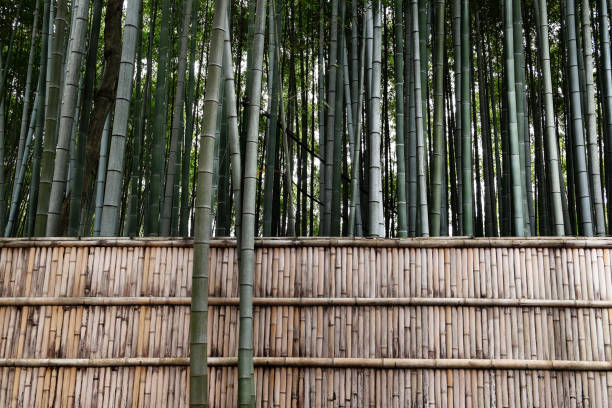
- Choose local bamboo varieties to minimize transportation impact and support the local economy. They are often more acclimatized to the regional climate and can provide unique aesthetic textures.
- Use treated bamboo for structure, as it has impressive tensile strength and is resistant to pests when cured properly. Research techniques like boron treatment for non-toxic pest prevention.
- Maximize natural light by designing open, airy spaces utilizing bamboo’s flexible structure for large windows and skylights. This reduces energy consumption and enhances the serene ambiance.
- Incorporate bamboo furniture and decorative elements to maintain a cohesive aesthetic. These include bamboo bath racks, shower mats, and screens, which can create a spa-like atmosphere.
- Focus on renewable energy sources such as solar panels that can be seamlessly integrated onto bamboo framework. This strengthens the sustainability aspect of the retreat.
- Create water-efficient systems by integrating bamboo-based aqueducts or rainwater filtration systems that enhance the eco-friendly profile and provide sustainable water management solutions.
- Ensure proper insulation with bamboo panels and thatched roofing options to retain the spa’s comfortable climate, reducing the need for artificial heating or cooling.
- Foster biodiversity by planting bamboo in landscaping to provide natural cooling and habitat for local wildlife, enriching the natural environment surrounding the retreat.
- Engage local craftspeople skilled in bamboo craftsmanship to design unique tailor-made elements, adding cultural authenticity and supporting traditional artisans.
Bamboo’s Role in Creating Calming and Natural Environments
Consider incorporating bamboo elements into your space to cultivate a calming and natural atmosphere. Bamboo’s gentle texture and natural tones complement various design styles, providing a serene backdrop for everyday life. The subtle sound of rustling bamboo can enhance tranquility, ideal for meditation spaces or restful garden retreats.
Bamboo’s versatility allows it to be used in screens and panels, offering privacy while maintaining an open feel. Its sustainable nature aligns with eco-friendly initiatives, making it a smart choice for those seeking harmony with nature. Additionally, bamboo furniture pieces bring warmth and simplicity, inviting you to relax and unwind.
Transform outdoor areas by using bamboo fencing or trellises, which not only define spaces but also integrate seamlessly with greenery, promoting a sense of cohesion with the environment. Indoors, bamboo flooring provides a soft, inviting touch underfoot, adding a warm, organic quality to living spaces.
For those looking to integrate more natural elements in their environments, bamboo plants themselves can bring the outdoors in, purifying air and adding life to any room. By choosing bamboo, you contribute to creating spaces that foster peace, clarity, and a deep connection to nature.
Cost Analysis: Budgeting for Bamboo Construction
Begin your bamboo construction budgeting by performing a detailed analysis of material costs. Bamboo is typically more affordable than traditional building materials like wood or concrete, with prices averaging $2 to $5 per linear foot. Comparing suppliers and sourcing locally can further reduce expenses. Consider bulk purchasing, which may result in discounts from suppliers and reduce overall transport costs.
Labor costs should also be examined carefully. Opting for local labor not only minimizes fees but also supports the local economy. Specialized bamboo artisans may command higher wages, but their expertise can enhance the quality of construction, potentially reducing long-term maintenance costs. Training your team on bamboo techniques may provide a balance between cost-efficiency and quality.
Factor in design costs, which can vary significantly based on complexity and customization. Consulting with architects experienced in bamboo construction may incur fees but can result in unique, structurally sound designs that maximize material efficiency.
| Expense Category | Estimated Cost (USD) |
|---|---|
| Material Costs | $2 to $5 per linear foot |
| Labor Costs | Varies by region and expertise |
| Design and Consultation | Plan for 10-20% of total budget |
| Transportation and Logistics | 5-10% of total budget |
Don’t overlook the costs associated with logistics and transportation. Planning your project timeline wisely can prevent unexpected shipping delays and additional expenses. Integrating contingency funds for unforeseen expenses ensures that your budget remains intact throughout the construction process.
An effective cost analysis will enable you to create a balanced budget, ensuring financial success for your bamboo construction project without compromising on quality or sustainability.
Integrating Bamboo with Modern Architectural Concepts
Leverage bamboo as a core structural element by exploring its natural flexibility and tensile strength. Implement bamboo in load-bearing applications, such as columns and beams, to benefit from its ability to withstand significant stress while maintaining aesthetic appeal. Collaborate with structural engineers to optimize bamboo’s integration with steel or concrete frameworks, ensuring safety and durability.
Utilize the thermal insulation properties of bamboo by incorporating it into wall systems and roofing. This not only enhances energy efficiency but also reduces overall building costs. Natural gaps in bamboo culms can provide passive ventilation, improving indoor air quality and comfort. Research the use of treated bamboo panels for facades, offering both modern visual style and sustainable credentials.
Consider the modularity of bamboo when designing versatile and adaptable spaces. Bamboo’s lightweight nature allows for easy transportation and assembly, making it ideal for projects requiring quick construction or future scalability. Experiment with prefabricated bamboo components, enabling quicker installation without compromising on design flexibility.
Integrate bamboo into biophilic design concepts by using it in interiors to create a connection with nature, promoting well-being and productivity. Bamboo furniture or interior cladding adds a warm and inviting atmosphere, while maintaining a sleek and modern appearance. Opt for bamboo finishes in floors and ceilings for a cohesive aesthetic throughout your architectural projects.
Finally, emphasize sustainable architectural practices by sourcing bamboo from certified plantations. This ensures the material’s renewability and aligns with green building certifications and initiatives. Engage with local craftsmen skilled in bamboo construction techniques to support community employment and preserve traditional knowledge, seamlessly blending innovation with cultural heritage.
Q&A:
Why is bamboo considered a strong building material?
Bamboo is renowned for its strength due to its high tensile strength, which is comparable to steel. The plant’s natural growth pattern features long fibers which provide flexibility and durability, allowing it to withstand heavy loads and resist breaking under pressure. This makes it an excellent choice for construction purposes, especially in regions prone to natural disasters like earthquakes.
How does bamboo’s growth rate contribute to its use in construction?
Bamboo is one of the fastest-growing plants on Earth, with some species growing up to three feet in a single day. This rapid growth means that it can be harvested frequently without depleting the resource, making it a sustainable alternative to traditional timber. Its quick regeneration cycle also reduces the environmental impact of using bamboo as a building material.
Can bamboo’s strength be enhanced through treatment or processing?
Yes, the strength of bamboo can be further enhanced through specific treatments and processing techniques. Processes like steaming or boiling can remove starches that attract pests and can increase durability. Additionally, chemical treatments can improve bamboo’s resistance to moisture, insects, and rot, extending its lifespan when used in construction.
Are there any limitations to using bamboo as a primary building material?
While bamboo is incredibly strong and sustainable, it does have some limitations. It can be vulnerable to insects and rot if not properly treated. Its structural performance can vary with species and age, necessitating careful selection and preparation. Additionally, the lack of standardization in bamboo construction can pose challenges in countries with strict building codes.
How does bamboo compare with traditional building materials like wood or steel in terms of cost?
Bamboo can often be more cost-effective than wood or steel, particularly in areas where it is abundant. Its rapid growth and renewability mean lower raw material costs, while processing expenses are generally less than those for steel. However, costs can increase due to necessary treatments and transport, especially if bamboo has to be imported to locations where it’s not locally available.
How does bamboo’s strength compare to traditional building materials like steel and concrete?
Bamboo is surprisingly strong and is often compared to steel and concrete. Its tensile strength is comparable to steel, meaning it can resist pulling forces very well. This makes it particularly suitable for construction in areas prone to natural disasters such as earthquakes. Additionally, bamboo’s compressive strength is also impressive, allowing it to handle weight like concrete. These properties, combined with its lighter weight, make bamboo a viable and sustainable alternative to more conventional building materials.
What factors influence the strength and durability of bamboo when used in construction?
The strength and durability of bamboo in construction are influenced by several factors. First, the species of bamboo chosen can significantly impact its performance; some species have higher density and tensile strength than others. Second, the age of the bamboo culms matters—mature bamboo poles, usually harvested after three to five years, offer optimal strength. Third, treatment processes to protect bamboo from pests and environmental conditions are crucial for its longevity. Finally, the construction techniques used to assemble bamboo structures can greatly affect the overall durability. Proper jointing techniques and design considerations ensure the structural integrity of bamboo buildings.
